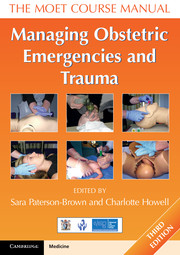Book contents
- Frontmatter
- Dedication
- Contents
- Working Group
- About the authors
- Acknowledgements
- Abbreviations
- Section 1 Introduction
- Section 2 Recognition
- Section 3 Resuscitation
- Section 4 Trauma
- Section 5 Other medical and surgical emergencies
- Section 6 Obstetric emergencies
- 24 Pre-eclampsia and eclampsia
- 25 Major obstetric haemorrhage
- 26 Caesarean section
- 27 Placenta accreta and retained placenta
- 28 Uterine inversion
- 29 Ruptured uterus
- 30 Ventouse and forceps delivery
- 31 Shoulder dystocia
- 32 Umbilical cord prolapse
- 33 Face presentation
- 34 Breech delivery and external cephalic version
- 35 Twin pregnancy
- 36 Complex perineal and anal sphincter trauma
- 37 Symphysiotomy and destructive procedures
- 38 Anaesthetic complications in obstetrics
- Section 7 Triage and transfer
- Section 8 Human issues
- Index
29 - Ruptured uterus
- Frontmatter
- Dedication
- Contents
- Working Group
- About the authors
- Acknowledgements
- Abbreviations
- Section 1 Introduction
- Section 2 Recognition
- Section 3 Resuscitation
- Section 4 Trauma
- Section 5 Other medical and surgical emergencies
- Section 6 Obstetric emergencies
- 24 Pre-eclampsia and eclampsia
- 25 Major obstetric haemorrhage
- 26 Caesarean section
- 27 Placenta accreta and retained placenta
- 28 Uterine inversion
- 29 Ruptured uterus
- 30 Ventouse and forceps delivery
- 31 Shoulder dystocia
- 32 Umbilical cord prolapse
- 33 Face presentation
- 34 Breech delivery and external cephalic version
- 35 Twin pregnancy
- 36 Complex perineal and anal sphincter trauma
- 37 Symphysiotomy and destructive procedures
- 38 Anaesthetic complications in obstetrics
- Section 7 Triage and transfer
- Section 8 Human issues
- Index
Summary
Objectives
On successfully completing this topic, you will be able to:
discuss the risk factors for uterine rupture
recognise a ruptured uterus early
plan and manage a ruptured uterus.
Introduction
Complete rupture of the uterus can be a life-threatening emergency. Fortunately, however, the condition is rare in modern obstetrics, despite the increase in CS rates, and serious sequelae are even more rare.
Incidence and predisposing factors
Population studies, including large numbers (>50 000) of patients over the last few decades, give a low overall incidence of uterine rupture at approximately 0.3/1000 deliveries. Rupture is more likely in multigravid women, especially those who have undergone previous CS, but spontaneous rupture of the unscarred uterus does occur. Risk factors for rupture of an unscarred uterus include:
• grand multiparity
• undiagnosed cephalopelvic disproportion or malpresentation
• oxytocin administration
• macrosomic fetus
• placenta percreta
• prior uterine surgery
• version
• uterine abnormalities (e.g. rudimentary horn).
Previous CS
Smith et al. looked at 35 854 women who laboured with a previous CS: 74.2% had a vaginal delivery and the incidence of uterine rupture was 0.35%. The risk was higher among women who had not previously given birth vaginally and those whose labour was induced with prostaglandin. Al Zirqi et al. reviewed 18 794 women who gave birth after a CS in Norway from 1999 to 2005. Compared with elective prelabour CS, the odds ratio for rupture with spontaneous labour was 6.65, and for induced labour 12.6. Induction, using prostaglandins, increased the odds for rupture by 2.72 compared with spontaneous labour.
- Type
- Chapter
- Information
- Managing Obstetric Emergencies and TraumaThe MOET Course Manual, pp. 339 - 346Publisher: Cambridge University PressPrint publication year: 2014

